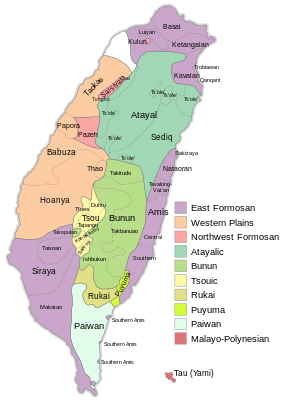
Taiwanese indigenous peoples, also known as Native Taiwanese, Formosan peoples, Austronesian Taiwanese, Yuanzhumin or Gaoshan people, and formerly as Taiwanese aborigines, are the indigenous peoples of Taiwan, with the nationally recognized subgroups numbering about 569,000 or 2.38% of the island's population. This total is increased to more than 800,000 if the indigenous peoples of the plains in Taiwan are included, pending future official recognition. When including those of mixed ancestry, such a number is possibly more than a million. Academic research suggests that their ancestors have been living on Taiwan for approximately 6,500 years. A wide body of evidence suggests that the Taiwanese indigenous peoples had maintained regular trade networks with numerous regional cultures of Southeast Asia before the Han Chinese colonists began settling on the island from the 17th century, at the behest of the Dutch colonial administration and later by successive governments towards the 20th century.

The Austronesian languages are a language family widely spoken throughout Maritime Southeast Asia, parts of Mainland Southeast Asia, Madagascar, the islands of the Pacific Ocean and Taiwan. There are also a number of speakers in continental Asia. They are spoken by about 386 million people. This makes it the fifth-largest language family by number of speakers. Major Austronesian languages include Malay, Javanese, Sundanese, Tagalog (Filipino), Malagasy and Cebuano. According to some estimates, the family contains 1,257 languages, which is the second most of any language family.
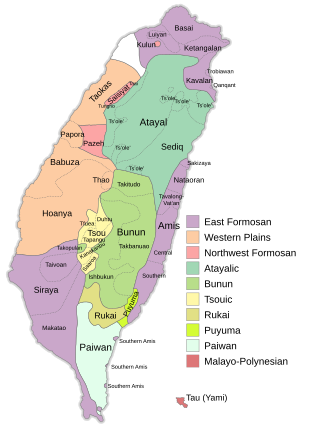
The Formosan languages are a geographic grouping comprising the languages of the indigenous peoples of Taiwan, all of which are Austronesian. They do not form a single subfamily of Austronesian but rather nine separate subfamilies. The Taiwanese indigenous peoples recognized by the government are about 2.3% of the island's population. However, only 35% speak their ancestral language, due to centuries of language shift. Of the approximately 26 languages of the Taiwanese indigenous peoples, at least ten are extinct, another four are moribund, and all others are to some degree endangered.
The naming customs of Indigenous Taiwanese are distinct from, though influenced by, the majority Han Chinese culture of Taiwan. Prior to contact with Han Chinese, the Indigenous Taiwanese named themselves according to each tribe's tradition. The naming system varies greatly depending on the particular tribes. Some tribes do not have family names, at least as part of the personal name.

The Thao/Ngan are a small group of Taiwanese indigenous peoples who have lived near Sun Moon Lake in central Taiwan for at least a century, and probably since the time of the Qing dynasty. The Thao/Ngan people numbered around 800, making them one of the smallest of all of the recognized indigenous peoples in Taiwan.

The Amis, also known as the Pangcah, are an indigenous Austronesian ethnic group native to Taiwan. They speak the Amis language, an Austronesian language, and are one of the sixteen officially recognized Taiwanese indigenous peoples. The traditional territory of the Amis includes the long, narrow valley between the Central Mountains and the Coastal Mountains, the Pacific coastal plain eastern to the Coastal Mountains and the Hengchun Peninsula.

The Siraya people are a Taiwanese indigenous people. The Siraya settled flat coastal plains in the southwest part of the island of Taiwan and corresponding sections of the east coast; the area is identified today with Tainan City and Taitung County. At least four communities make up the group: Mattauw, Soelangh, Baccloangh, and Sinckan. The first four communities correspond to the modern-day districts of Madou, Jiali, Shanhua, and Sinshih, respectively.
The term "Taiwanese people" has various interpretations. It may generally be considered the people living on the island of Taiwan who share a common culture, ancestry and speak Mandarin, Hokkien, Hakka, or indigenous Taiwanese languages as a mother tongue. Taiwanese people may also refer to the indigenous peoples of the areas under the control of the Government of the Republic of China since 1945, including Kinmen and Matsu Islands that collectively form its streamlined Fujian Province. However, the inhabitants of Kinmen and the Matsu Islands themselves may not consider the "Taiwanese" label to be accurate as they are a part of Fujian and not Taiwan. They have a distinctive identity from that of the Taiwanese; viewing themselves as Kinmenese or Matsunese, respectively, or as simply Chinese.
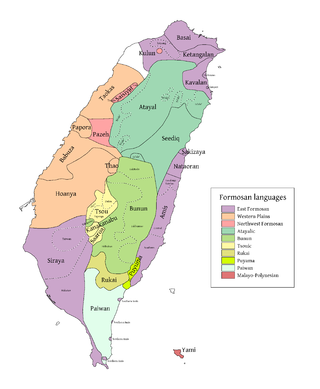
Saisiyat is the language of the Saisiyat, a Taiwanese indigenous people. It is a Formosan language of the Austronesian family. It has approximately 4,750 speakers.

The languages of Taiwan consist of several varieties of languages under the families of Austronesian languages and Sino-Tibetan languages. The Formosan languages, a geographically designated branch of Austronesian languages, have been spoken by the Taiwanese indigenous peoples for thousands of years. Owing to the wide internal variety of the Formosan languages, research on historical linguistics recognizes Taiwan as the Urheimat (homeland) of the whole Austronesian languages family. In the last 400 years, several waves of Han emigrations brought several different Sinitic languages into Taiwan. These languages include Taiwanese Hokkien, Hakka, and Mandarin, which have become the major languages spoken in present-day Taiwan.
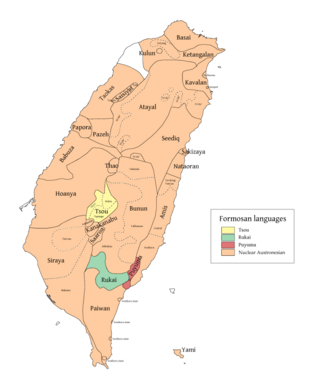
Tsou is a divergent Austronesian language spoken by the Tsou people of Taiwan. Tsou is a threatened language; however, this status is uncertain. Its speakers are located in the west-central mountains southeast of the Chiayi/Alishan area in Taiwan.
Kanakanavu is a Southern Tsouic language spoken by the Kanakanavu people, an indigenous people of Taiwan. It is a Formosan language of the Austronesian family.

Saaroa or Lhaʼalua is a Southern Tsouic language spoken by the Saaroa (Hla'alua) people, an indigenous people of Taiwan. It is a Formosan language of the Austronesian family.

The Sakizaya are Taiwanese indigenous peoples with a population of approximately 1,000. They primarily live in Hualien, where their culture is centered.

The population of Taiwan is approximately 23.35 million as of April 2023.

The Qauqaut were a Taiwanese aboriginal people who lived primarily in the town of Su-ao in Yilan County. They spoke the Basay language, which is a Kavalanic language, an Austronesian language family of Taiwan. According to Japanese anthropologist Inō Kanori, the Qauqaut people had been assimilated by the Kavalan people by early 20th century. The Qauqaut people are not recognised by the government of Taiwan.
Taiwanese Australians are Australian citizens or permanent residents who carry full or partial ancestry from the East Asian island country of Taiwan or from preceding Taiwanese regimes.
Benshengren, are ethnic Hoklo or Hakka Taiwanese nationals who settled on the island prior to or during the Japanese colonization of Taiwan. Its usage is to differentiate the different culture, customs, and political sentiments within contemporary Taiwan between those who lived through World War II on the island and later migrants from Mainland China, who are known as Waishengren. Hoklo and Hakka people who migrated to Taiwan after 1945, especially those who migrated with the retreat of the Nationalist-Led Chinese Government to Taiwan in 1949 are not included in this term.
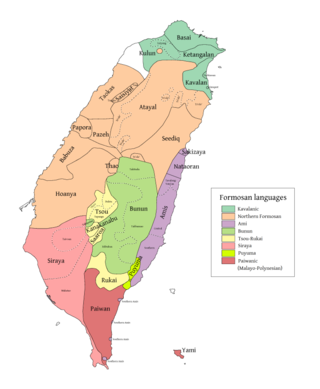
Taivoan or Taivuan, is a Formosan language spoken until the end of the 19th century by the indigenous Taivoan people of Taiwan. Taivoan used to be regarded as a dialect of Siraya, but now more evidence has shown that they should be classified as separate languages. The corpora previously regarded as Siraya like the Gospel of St. Matthew and the Notes on Formulary of Christianity translated into "Siraya" by the Dutch people in the 17th century should be in Taivoan majorly.

Plains indigenous peoples, previously called plain aborigines, are Taiwanese indigenous peoples originally residing in lowland regions, as opposed to Highland indigenous peoples. Plains indigenous peoples consist of anywhere from eight to twelve individual groups, or tribes, rather than being a single ethnic group. They are part of the Austronesian family. Beginning in the 17th century, plains indigenous peoples have been heavily influenced by external forces from Dutch, Spanish, and Han Chinese immigration to Taiwan. This ethnic group has since been extensively assimilated with Han Chinese language and culture; they have lost their cultural identity, and it is almost impossible without careful inspection to distinguish plains indigenous peoples from Taiwanese Han people.
